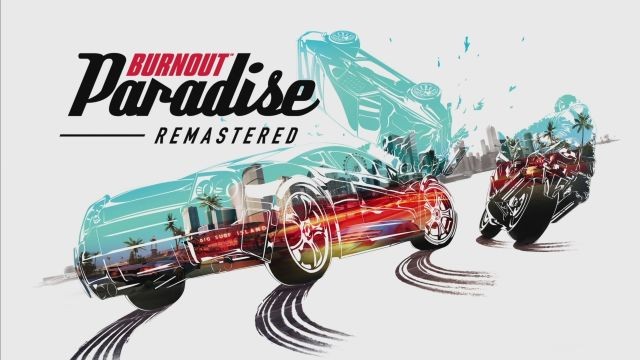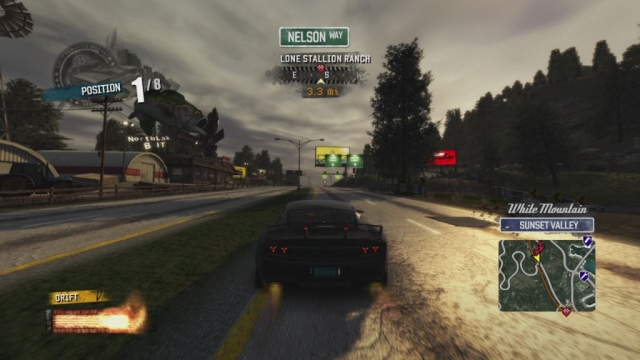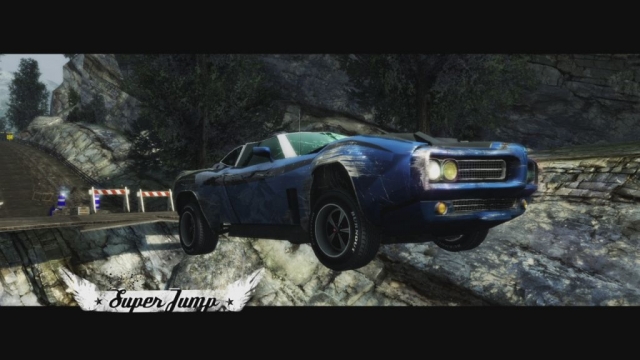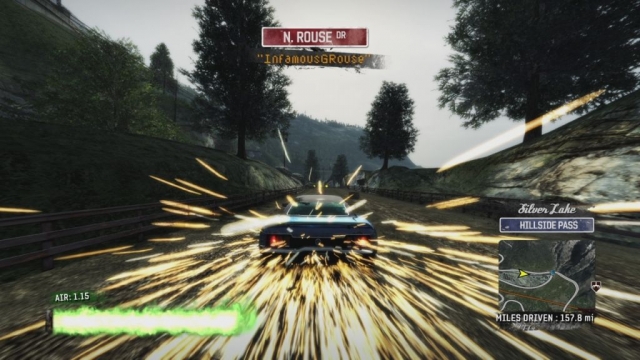Burnout Paradise Remastered

Burnout Paradise was a pioneer in open-world racing in 2008. Its seamless blend of online and offline play was years ahead of its time. Being able to spend hours offline and build up your skills and in-game licenses to then hop online was fresh, and the variety of new additions to the franchise beyond a fairly large change like a switch to an open-world format helped it stand out. At the time, the only thing like Burnout Paradise was something out of the Midnight Club series, which was an arcade-infused racer, but one that struggled with making its open world an interesting one. Burnout Paradise countered that by having every road give you something to do – whether it’s engage in a race, takedown a rival car to add it to your collection, smash signage, or explore hidden routes covered up by traffic cones.
The world of Paradise City feels somewhat lived in, and the game itself has stood the test of time shockingly well for something with a decade of rust on its design. The large city map gives you a fair amount of guidance with different icons showcasing different events. Modes like Road Rage and races return, along with new challenges like burning route, marked man, and stunt run. Crash mode has been reworked as Showtime mode, and shifts the focus from pure chaos to a blend of chaos and ensuring that you keep your vehicle airborne for as long as possible. Races are about what they’ve always been in the franchise – but with a major twist. While you still want to come in first place and score as many takedowns as possible, the shift to an open-world design means that you can’t rely on a traditional track structure.
Instead of laps, you just have to go from Point A to B and beat everyone to the point. The open design means that things that might work as escape routes in other modes might act as a shortcut for you here, but they could also send you far off-course. In the end, you could be left with a loss and only a couple of smashed gates going towards your tally to show for it. Learning the roads is the absolute best way to win, but for anyone who struggles with navigation either in a game or real life, one easy way to at least prevail here is to just stay in second or third place and keep a healthy boost level in your reserves. Ideally, start off following the pack for a more complex race and then for the last mile or so, branch out on your own and try to succeed without following anyone. The end race marker gives you a clear indicator of where you need to be and by that point, you should have a fairly straight path to where you have to go.
Paradise City does have a lot of perils placed in your path towards the end of some races though. You have to stay alert and avoid things like ramps as they can send you skyward and either into traffic or flip you over. Fortunately, if you make a mistake, you can at least restart a race after the fact – but this game did come around before rewinds were a thing, so you do need to race with a fair amount of caution while still taking calculated risks. The large, sprawling map has every kind of event sprinkled around it – alongside junkyards to swap cars, auto repair shops to fix up your ride, and gas stations to bring your boost to its highest levels. The latter two can be accessed in-race, making some events much easier if you’re fortunate enough to use them.
Marked Man in particular benefits from having repair shops, as it is a race, but pits you against a slew of other drivers in burly cars. This means they can muscle you around with ease, and succeeding here requires a mixture of skill, evasion, and making use of shortcuts and side roads. Navigating through them is tougher, but allows you to avoid most enemies since they don’t usually go down those paths and you can still reach your final destination – the journey may just take slightly longer but still take less time than restarting from scratch. Marked Man is a fun challenge, and a great way to learn the city’s ins and outs.
Burnout Paradise Remastered brings all of the additional content, including DLC cars and Big Surf Island into the default game – so it offers up more content than the original game did even with its free updates. Unfortunately, more quality of life improvements that made the original game better haven’t been expanded upon here. That means there’s no fast travel option or even a menu to select from certain racing types. As a result, you still have to race around the large in-game world to find new events, and while that does allow you to learn the world, it also makes the experience far more time-consuming than it needs to be if all you want to do is race for a bit in an arcade-like racing game. Paradise Remastered is definitely the best way to play the game now, but if it had some quality of life improvements made to it, it would be that much better.
Visually, Paradise Remastered holds up quite nicely. With the original Xbox 360 game being playable on the Xbox One, it’s quite easy to see how many improvements have been made. Lighting effects have been boosted – with more sparks during grindfests and better-looking reflections. The jaggies that permeate the original version on modern displays are gone, and a far smoother appearance enables the action to look a bit better overall. The framerate was never a problem before and remains rock-solid here, with fast races never chugging no matter how much action is going on at one time. The environments themselves haven’t gotten much of a tune-up, but they didn’t really need one. The billboards have been adjusted to say remastered, while minor increases in detail are evident that further the idea that Paradise City is a lived-in world with rundown structures from time to time.
The Burnout franchise has always had strong sound design – and that’s something Criterion has always excelled at regardless of genre. Their FPS effort Black had some timeless bullet effects, and Paradise has some of the strongest sound effect work when it came out. Being surrounded by rivals led to you simply sounding overwhelmed by the amount of noise around you, and that feeling continues on here. While it may sound odd, it’s strangely empowering to know that you have all of these odds around you to overcome, and it leads to races being even more exciting. DJ Atomika is the only sour spot for the audio, as the licensed soundtrack is a fun listen – even if nothing quite tops the original Xbox days of being able to fully tailor an in-game OST and have it blend in seamlessly with the game.
Overall, Burnout Paradise Remastered is the best way to experience the game. While it does have some rough edges caused by time moving forward and work not being done to better-modernize it, the game is still a riot. Playing through it in a revamped form with all of the additional content made it a bit more fun to do it now than it was a decade ago, and it’s a testament to getting things done right the first time that this game can still work as a modern release in 2018 and still be a high-quality game. It’s a must-own for anyone who likes fast racing action, and hopefully leads to more Burnout games getting re-released on modern platforms so more players can enjoy them.
Reviewed By: Jeremy Peeples
Publisher: Electronic Arts
Rating: 90%
——————————————————————————–
This review is based on a digital copy of Burnout Paradise Remastered for the Xbox One provided by Electronic Arts.
 Game Over Online
Game Over Online











